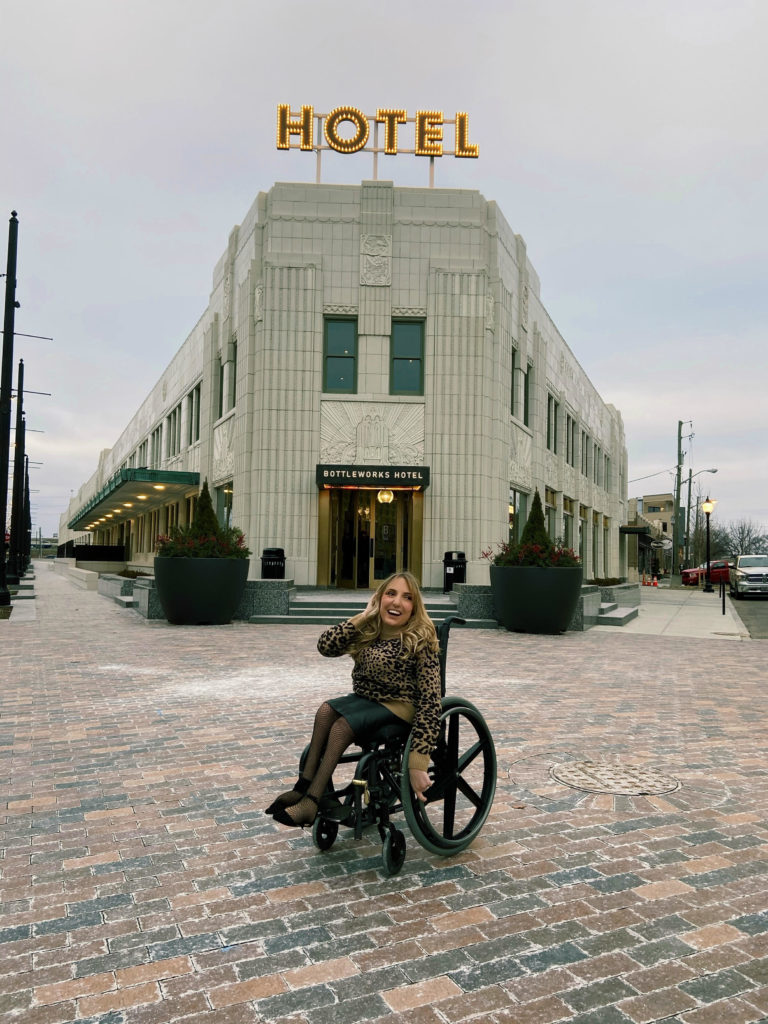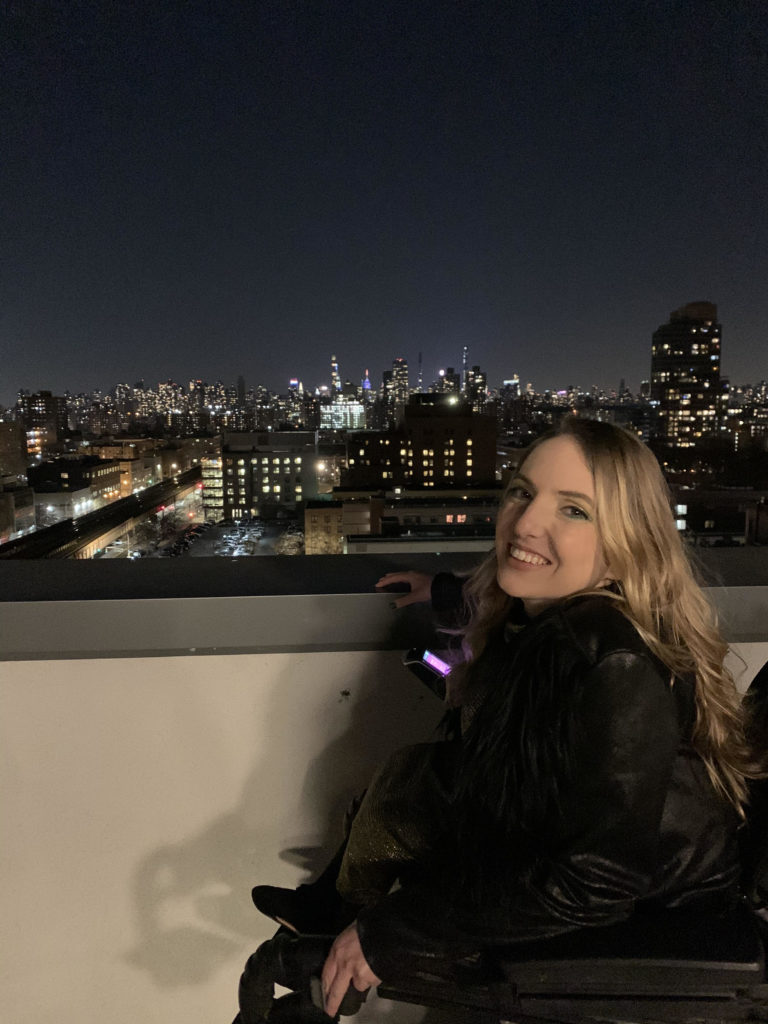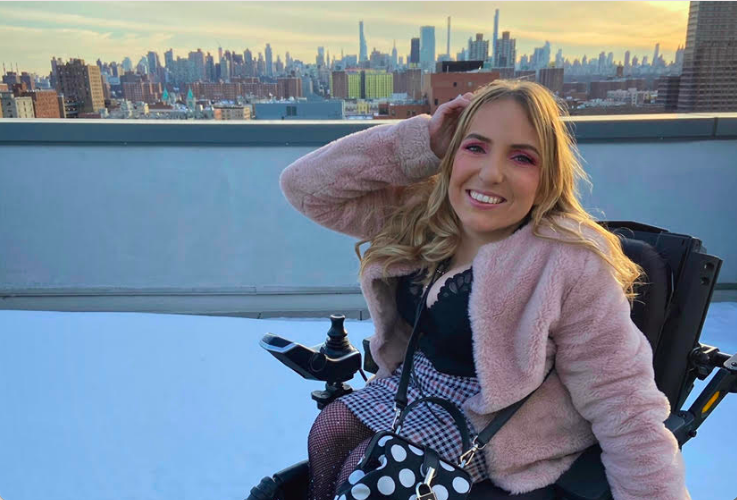Meet Kaycee Marshall, Assistant Designer at Juniper Unlimited – Global Brands Group. Kaycee has been featured on The Today Show and we cannot wait to share her story & message with you.
What inspired you to become a fashion designer?
Even in elementary school, I was sketching clothes in crayon. Fashion is a way to express yourself and also feel confident. I know I have gained a lot of confidence from finding my own personal style and being able to express that. I would flip through fashion magazines as a teenager and wonder why people with disabilities were excluded. Women with disabilities are just as glamorous and beautiful as the models on those glossy magazine pages. The fashion industry is notorious for its lack of diversity.
Wherever my career takes me, my goal is to empower, give independence, and build confidence for people with disabilities through adaptive clothing. I want to increase understanding and acceptance through diversity and representation in the fashion industry.
How do you wish to be viewed/treated?
People with disabilities are JUST people. You should treat us the way you treat anyone else. We are just trying to live our lives and saying things like “you’re so inspirational” can be patronizing when we are doing ordinary or mundane tasks. I am not inspirational for opening my own door to pick up a shaken brown sugar oat milk espresso at Starbucks. I think people should ask themselves “if a nondisabled person did this would it still be inspirational?”
What are some ways the fashion industry can be more inclusive?
I think the easiest way to become more inclusive is start hiring people with disabilities. Include disabled models, designers, makeup artist, etc. in your marketing campaigns. You don’t have to have adaptive product to include a disabled model.
What is the opportunity for adaptive fashion?
Adaptive fashion is a huge untapped market. The New York Times even called it fashion’s “new frontier,” with a noticeable amount of designers and brands featuring disabled models and clothing designs for the disabled. This market will continue to grow and brands do not want to be left behind with this opportunity. Not only is it a smart business move, but you are changing lives by offering authentic representation and allowing people to get their dignity back by getting dressed with ease.

How have you adapted the design process?
Industrial sewing machines are built with the foot pedal mounted into the floor, but I do not have enough strength in my feet to press down on the pedal or the height to reach a foot pedal on the ground. I like to use a home sewing machine because it has a moveable pedal. I place it in between my knees to control the speed of the machine and that way I have both hands to control the fabric. The heights of the dress forms and patternmaking tables in the studio can be a problem, but luckily my power wheelchair has an adjustable height.
What keeps you going during tough or challenging times?
I have an amazing support system of family and friends who encourage even my wildest dreams. I always have them to fall back on and call when I need support. …that and shopping. Never underestimate the therapeutic benefits of shopping. LOL
Tell us about the importance of representation.
I would flip through fashion magazines as a teenager and wonder and see all these beautiful people who looked nothing like me. It wasn’t until social media that I found other people with the same condition I have and could see other women with bodies like mine. It validated my existence and made me feel less alienated. The difference seeing a model in a wheelchair on the cover of the Vogue magazines I got every month would have been revolutionary to my self confidence. Representation really does matter
and every brand should be striving to be more inclusive.
What brands are doing it right in terms of adaptive fashion?
I think one of the most important things an adaptive fashion brand should be doing is including people with disabilities through out the whole process. Inclusive hiring in this case is very important. Nothing about us without us. Another important piece of this is competitive pay and making sure that people with disabilities that are brought on to the project are being compensated fairly. There is a huge employment gap and pay wage gap for people with disabilities and anyone working in this space should
be working to close it.
As for the designs, we want fashion forward clothing just like anyone else! I love brands that understand that function should not compromise fashion. I not only want to be able to wear the garment, but to look good in it too. I would encourage adaptive brands to continue to push the envelope in design and keep the fashion forward looks coming!

How do you tackle challenges or obstacles that come your way? Tell us about The Kaycee Way!
By necessity, disabled people are some of the most creative people you will ever meet. We are constantly navigating a world that isn’t built for us. We are forced to be continuously adapting and innovating in order to navigate our community. My mom always said I always find “The Kaycee Way” in
order to gain access.
Since there is such a wide variety in the disability community, how do you navigate this when designing and keeping lots of different types of bodies in mind?
I have scoliosis so I know first hand the struggle of dressing an atypical body type. I look for clothes that have a lot of stretch and adjustability. For example, when I did my adaptive evening wear collection at Kent State, I would often use knit fabrics in replace of woven or add elastic to give the garment stretch.
Although I have a disability, it was also so important for me to talk to others in the community to get feedback. People with disabilities are so diverse it was imperative to converse with others within the community.
What has been your favorite thing about moving to New York City?
New York has amazing energy. As a creative, it inspires me every day. The city is so big and diverse compared to my small town and I loved finding my community here in New York. I finally have friends who use a wheelchair and have other disabilities.
Disabled isn’t a dirty word! Let’s discuss.
There are still so many misconceptions about disability in our society. Disability is NOT a bad or shameful thing and isn’t something that deserves pity. I am disabled. That is as much as part of my identity as my religion, race, or sexuality. When there is no shame in disability, there is no reason to avoid the word.

Tell us about how you found your community & what they have meant to you.
Finding my community has been one of the most impactful events of my life. Having people I can relate to within the disability community has strengthened my self- confidence and helped me establish my
identity as a disabled woman. As a teenager, I wanted to fit in and feel a sense of belonging. There was no amount of straightening my hair or Hollister tee shirts that could hide my wheelchair and make me look like the other kids.
My differences made me feel alienated. Attending a very small high school, I was the only person that used a wheelchair or any kind of mobility device in the entire school. I longed to find other people with disabilities. People who would understand access needs, ableism, and having complex medical needs. Through social media, I was able to reach out to the disability community and even find people that have the same rare condition I have.
Suddenly, I found people who proudly spoke about their experiences as a disabled person, and I saw disabled bodies that were shaped like mine. It sounds silly, but seeing people who actually look like me validated my existence. I finally found people who I could talk to, who understood the struggles and triumphs of having a disability.
Everyone deserves a sense of community and belonging, so if you don’t have that yet, please reach out and find your people. Mine have touched my life and empowered me in ways you wouldn’t believe. Through my community of powerful disabled activists and friends, I feel confident in my identity as a disabled woman.
How can we be allies to the disability community?
There are SO many ways to be a good disabled ally and it all starts by listening! Share our content with your friends and don’t talk over us when we speak out about our experiences. People need to prioritize disabled voices over nondisabled when talking about issues related to disability and accessibility. They should work to educate themselves on disability and advocate for our rights.
Even when it is hard we need allies to speak up when things don’t seem fair or aren’t accessible for all. When someone is being ableist, call them out. It’s 2021 there’s no room for ableist language and slurs. I am so thankful that my friends have become my biggest allies, and everyone can do it too.
Disability advocates speak out all the time on social media. Follow their accounts, listen, educate yourselves, and take our lead! Especially include disabled POC & LGBTQ+ on your feeds. Because intersectionality in your activism is SO important.
What would you say to your teenage self?
I would first give her the biggest hug and encourage her to keep designing, drawing, and sewing. My teenage self had big dreams that I feel blessed and lucky to currently be living those dreams out. I wish my teenage self knew her worth. She was so uncomfortable with her body and her disability.
I avoided shorts and swimsuits and honestly felt so miserable in the summer because of the fear of what others might think or say. I wish teenage me knew she didn’t owe the Karen’s of the world her medical history just because her surgery scars were visible. I also REALLY wish teenage me knew that her disabled body was valid and she was allowed to feel good about herself. Not just good, but confident in her body.
I proudly wear whatever I want now. My journey with self love truly taught me that clothing should give me confidence instead of shame. I proudly wear whatever I want now that I feel secure in my disabled
body.
How do you view your wheelchair?
I am so grateful for my wheelchair. There are definitely still misconceptions in society that using a wheelchair is somehow a bad thing or limiting. But for me, my wheelchair is my independence and my freedom. It’s just a tool to get me where I need to go.
My wheelchair gives me the confidence to go out in the world. My power chair is affectionately named “Becky” a nod at Beyoncé’s “Becky with the good hair” but instead “Becky with the good chair.”

Tell us about Yarrow.
Part of the JUNIPERunltd family of brands, Yarrow brings a sense of ease to everyday dressing. Inspired by the ancient herb known for its protective, healing and calming qualities, Yarrow features comfortable, soft layering and draping, all with hidden magnetic closures powered by MagnaReady®’s
patented magnetic technology. With styles named after members of the disability community, Yarrow is designed with accessibility in mind.
Where can people find you?
Instagram: @kayceecouture
Twitter: @kaycee_couture
Clubhouse: @kayceecouture
Kaycee Marshall
BY

you said: